In marketplaces, many systems are implemented to govern processes, optimize, and regularly improve them. Depending on the needs, these integrations vary as well, each offering something unique and perfectly suitable.
In the scope of this article, we have Product Information Management (PIM), Enterprise Resource Planning (ERP), and Digital Asset Management (DAM) to look at. Each one of these is a unique integration that can help your marketplace with whatever issues you may have.
Defining PIM, ERP, and DAM
Product Information Management (PIM)
PIM systems act as centralized hubs for managing detailed product information. They are created to bring consistency across sales channels, ecommerce platforms, and marketing materials. As such, with a PIM system, your business can:
- Consolidate and standardize product catalog management, descriptions, specifications, and pricing data.
- Distribute accurate product details across websites, marketplaces, and catalogs.
- Improve collaboration by providing a single source of truth for product information.
In short, PIM is irreplaceable for companies managing large product catalogs and working with multiple sales and distribution channels.
Speaking of examples, there are a bunch of tools worth noting.
- Akeneo. A well-known open-source PIM that can help marketing professionals organize and improve product data.
- Salsify. This tool combines PIM features with product experience management, which is commonly used in online shopping.
- Pimcore. This is an open-source tool featuring PIM, DAM, and CMS integrations.
- inRiver PIM. This tool focuses on B2B and B2C commerce and is a great choice for managing complex product content.
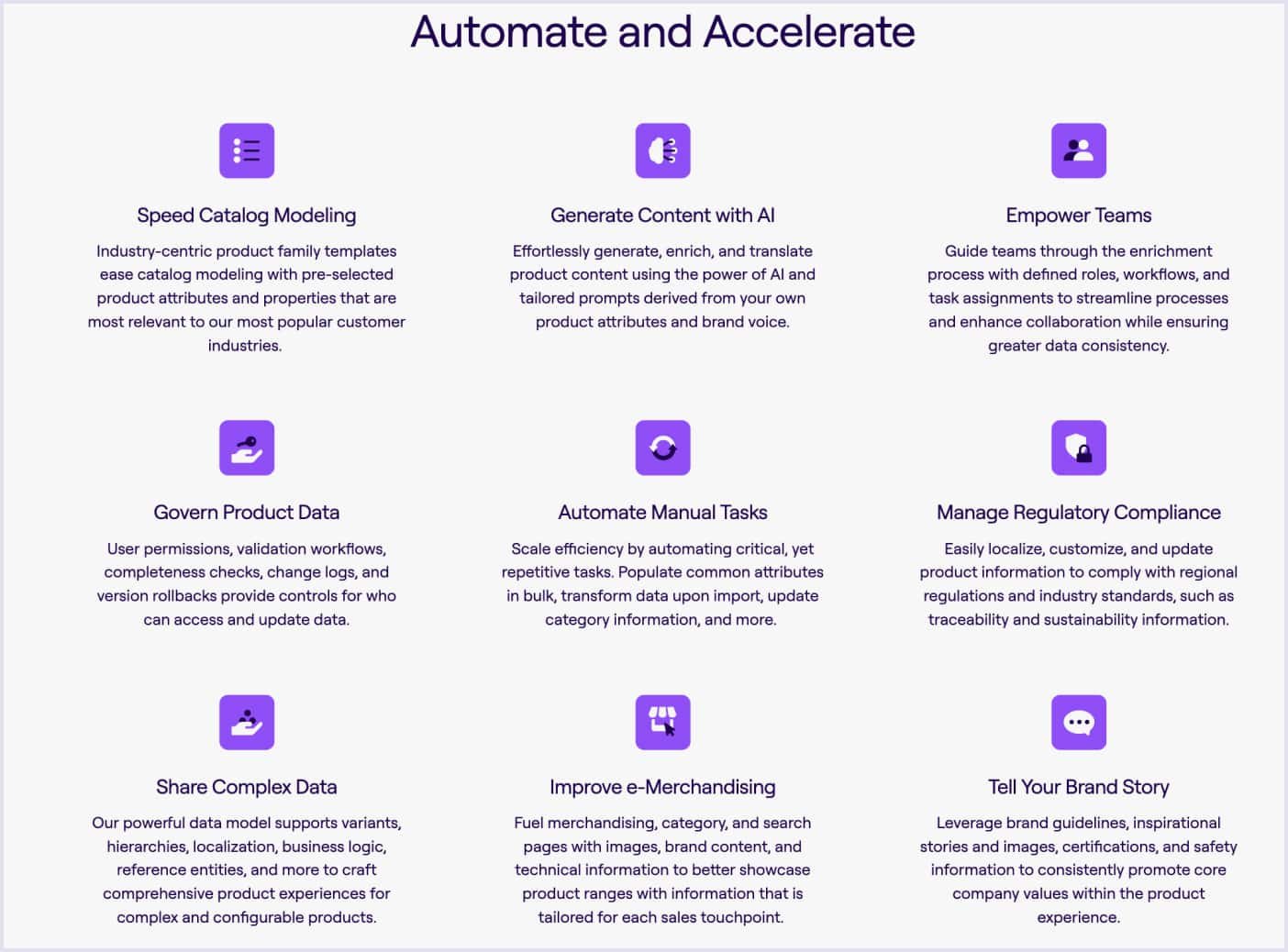
Source: Akeneo
Enterprise Resource Planning (ERP)
ERP systems integrate various business processes into a unified platform. This ultimately helps businesses manage finance, supply chain, HR, and inventory. As such, ERP usually governs:
- Automating order processing, procurement, and inventory tracking;
- Centralizing financial reporting, payroll, and compliance management;
- Enhancing visibility into supply chain operations and resource planning.
ERP systems are mostly used for internal tasks and cannot really handle complicated product data or digital assets. This is a great point to compare PIM and DAM tools, which we’ll cover later. Meanwhile, in the field of ERP, some examples are:
- SAP ERP. A leading ERP used by large enterprises for end-to-end business operations.
- Oracle NetSuite. A cloud-based ERP system popular with mid-sized companies.
- Microsoft Dynamics 365. A suite of ERP and CRM tools suitable for a range of industries.
- Odoo. An open-source ERP with customizable modules for small to medium businesses.
Digital Asset Management (DAM)
DAM systems work as digital asset storage. They put digital assets (i.e., pictures, videos, product papers, marketing materials) in order. With DAM's help, businesses can:
- Keep a brand consistent by putting all of their digital information in one place;
- Make sure that accepted images, graphics, and marketing materials can be accessed quickly and safely;
- Make it easier for the marketing, design, and ecommerce teams to work together.
DAM is very helpful for companies that use pictures in their ecommerce, advertising, and branding because it keeps all of their media files organized, simple to find, and ready to be shared. The most well-known examples of DAM systems are:
- Bynder. A cloud-based DAM used for brand management and content delivery.
- Acquia DAM (ex. Widen Collective). Offers enterprise-level DAM with strong integration and metadata capabilities.
- Adobe Experience Manager Assets. Part of Adobe’s ecosystem, ideal for companies heavily invested in Adobe tools.
- Brandfolder. A user-friendly DAM known for its strong analytics and sharing features.
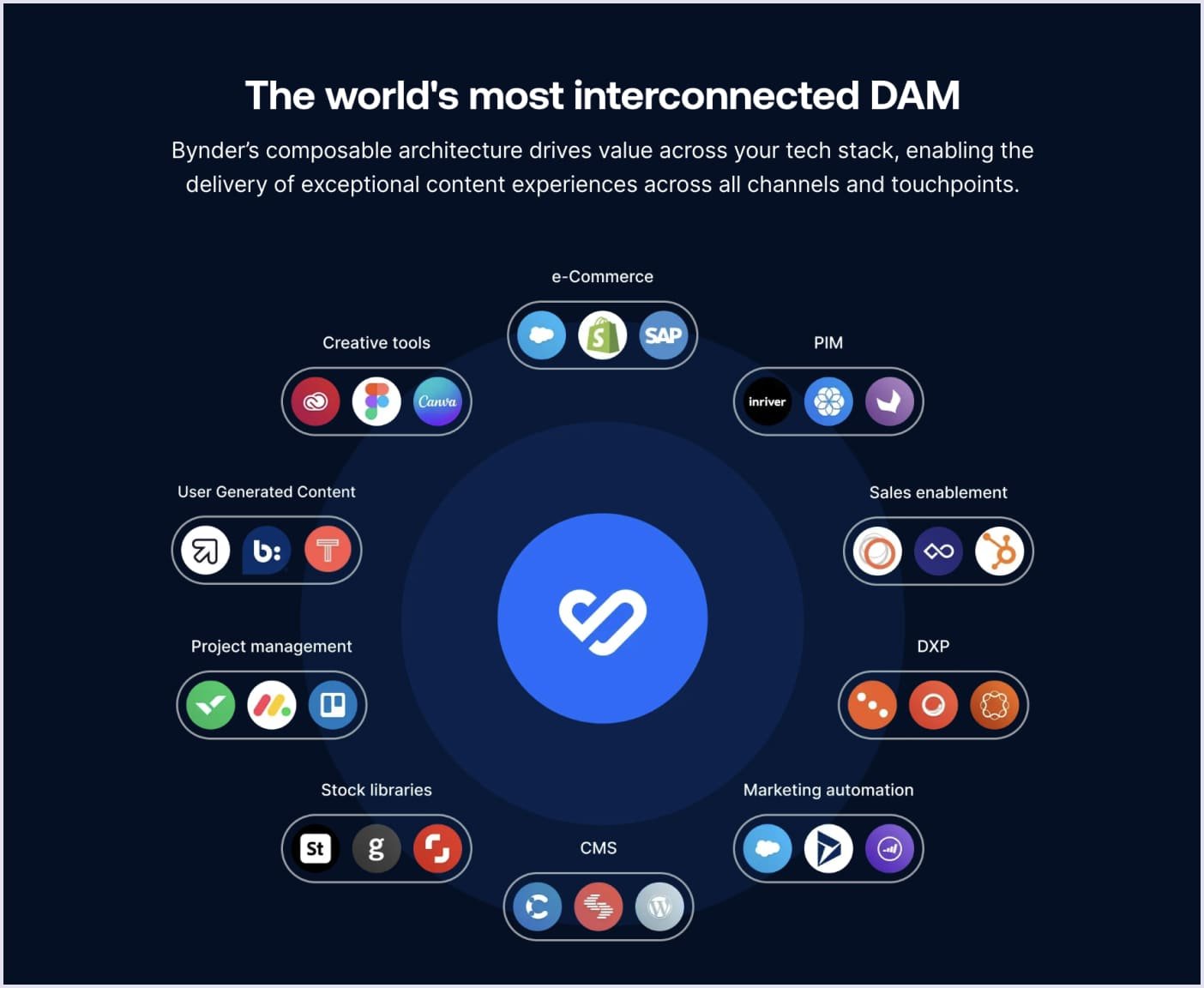
Source: Bynder
Key differences between PIM, ERP, and DAM
It is important for companies that want to improve their operations and marketing to know the differences between PIM, ERP, and DAM. The main things that set these systems apart are how they handle data, who they serve, and how well they can work with other systems. Let's look at each main difference.
Data focus
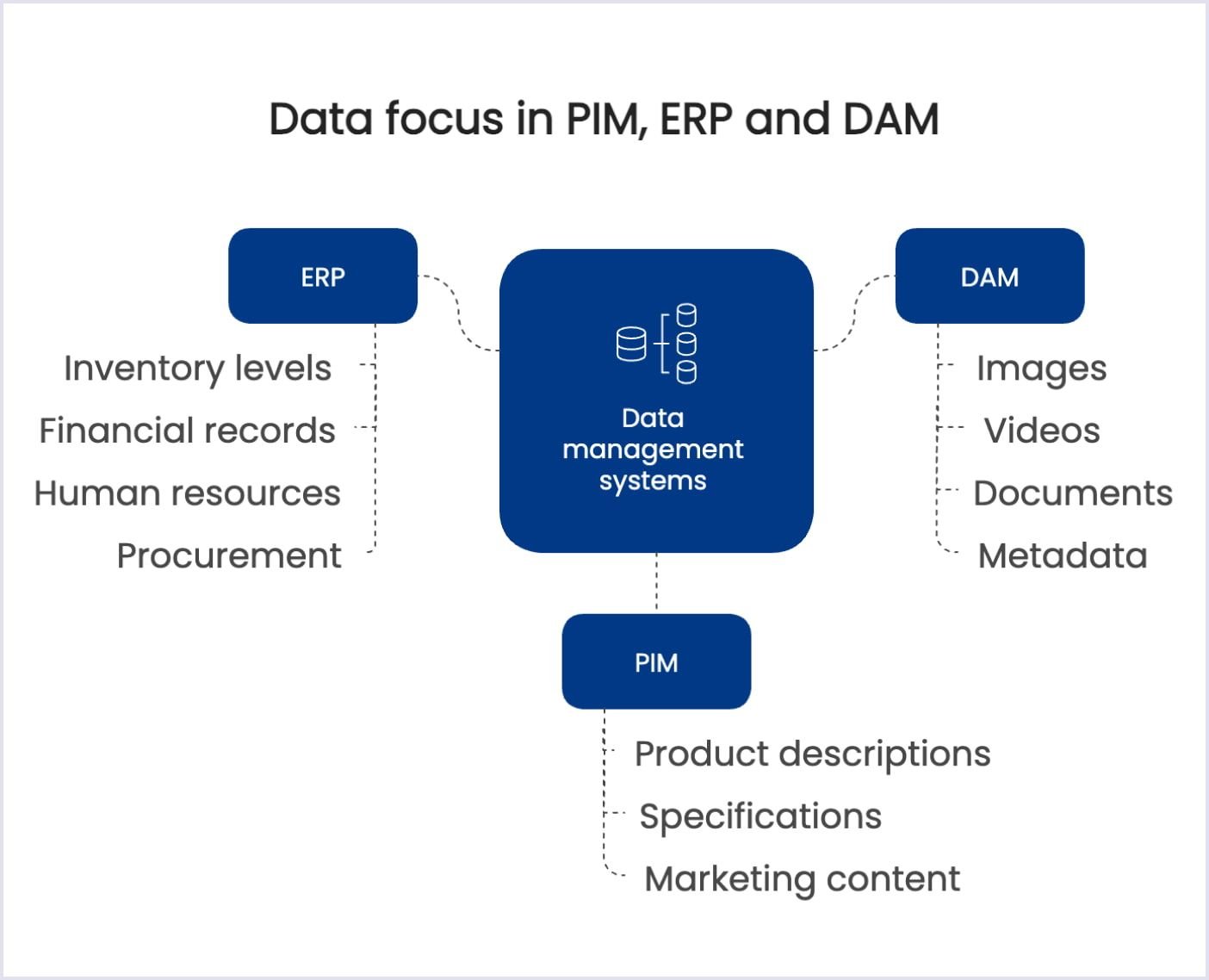
PIM is used to keep track of detailed information about products, like specs, marketing material, and descriptions. As a result, all product channels are consistent and correct, and customers have a better experience with reliable info.
ERP manages transactional data linked to the main functions of a business, such as purchasing, inventory levels, and financial records. It provides you real-time information about operational data that helps you make decisions every day.
DAM stores, organizes, and shares large amounts of media, including pictures, videos, papers, and the information that goes with them. It is critical to keep the brand consistent and make sure that digital material is easy to find for communication and marketing.
Primary users
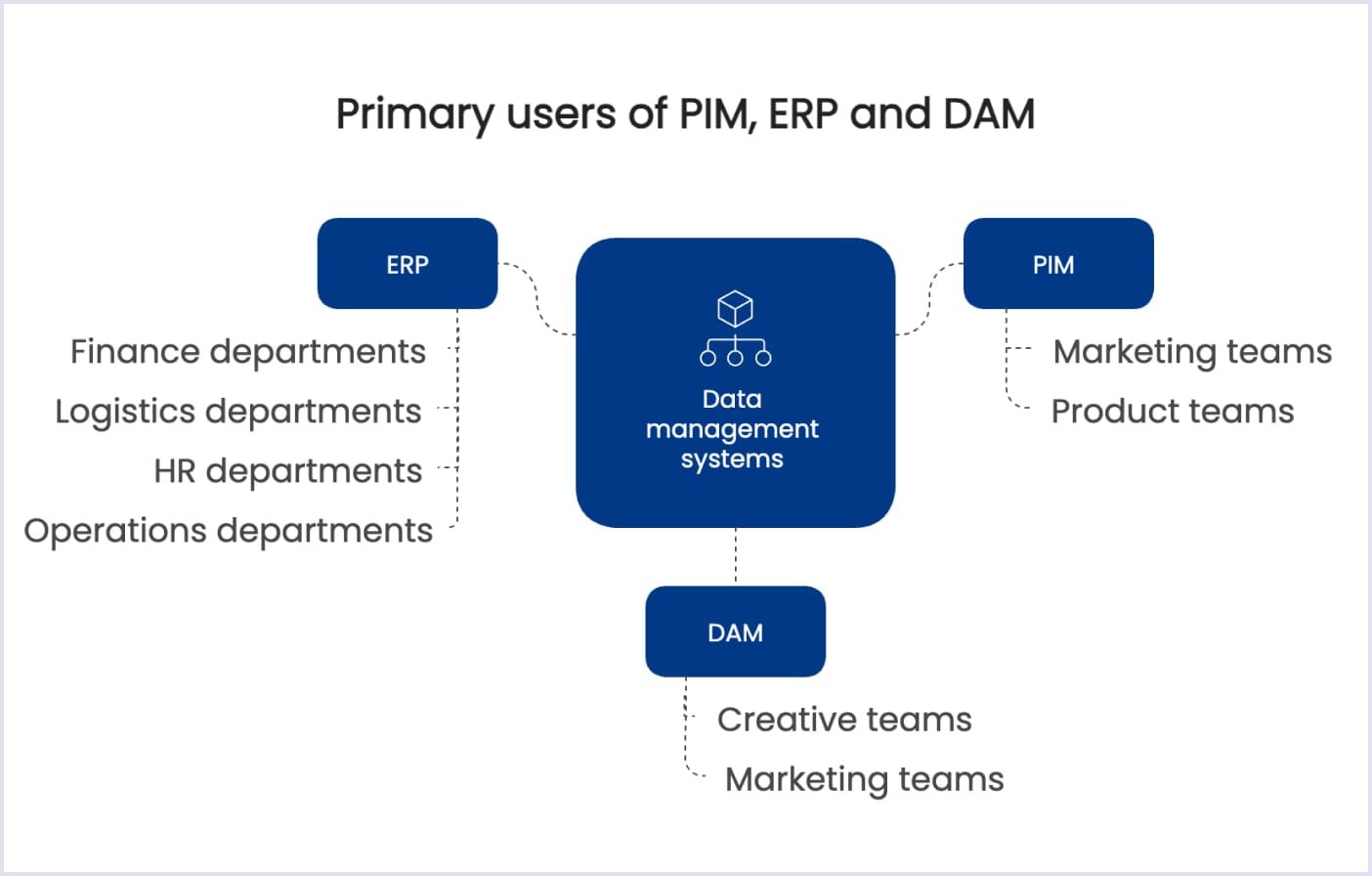
PIM is mostly used by marketing and product teams to make sure that all outlets show accurate, complete, and up-to-date information about their products.
ERP. Finance, logistics, HR, and operations are just a few of the departments that use it, which makes it an important part of how well the whole company works.
DAM. Creative and marketing teams like it because it makes it easy to manage assets and send digital material to support branding and advertising efforts.
Integration capabilities
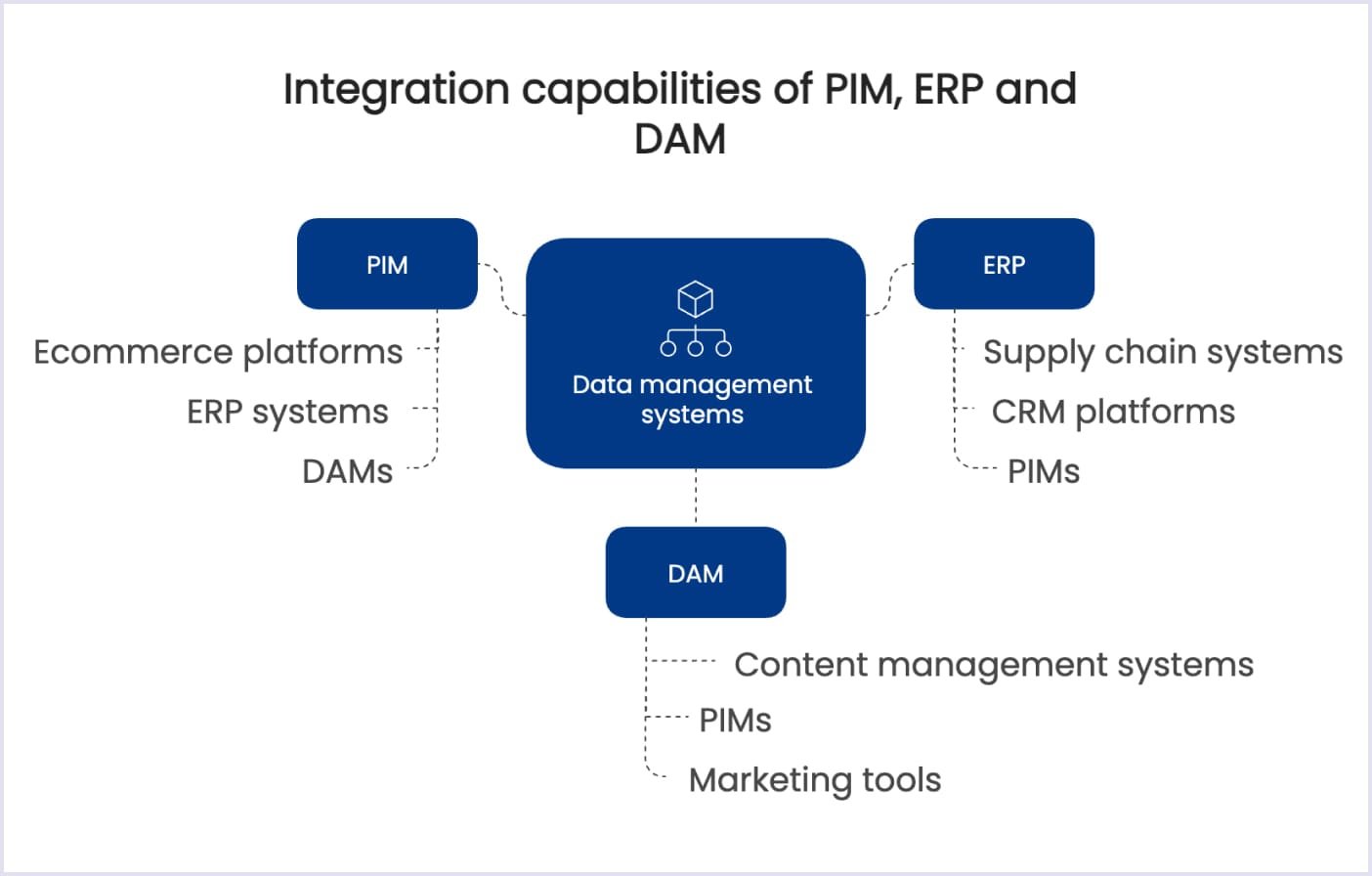
PIM usually works with e-commerce platforms, ERP systems, and DAMs, and it's like a hub that makes product data more complete across all channels.
ERP works with PIMs, CRM tools, and supply chain optimization systems to make it easier for transactional and operational data to move around the business.
DAM. There are many marketing tools and content management systems (CMS) that DAM works with to make sure that digital assets are used consistently across campaigns and platforms.

When to use PIM, ERP, and DAM systems
What your business needs will determine whether you choose PIM, ERP, or DAM. You can use these platforms together, but remember that they each have their own role to play in managing digital assets, business processes, or product information. Thus, we’d better look at the best use cases to avoid any confusion.
Implementing a PIM system
A PIM system is ideal for businesses that manage large product catalogs and need to distribute consistent product data across multiple sales channels. It works well for ecommerce businesses that sell on websites, marketplaces, and in stores, as well as for makers and wholesalers who need to make sure their product specs are correct.
PIM integration can also help companies that have trouble with inconsistent or missing product data or marketing teams that need specific product descriptions, attributes, and digital assets for promotions.
Implementing an ERP system
An Enterprise Resource Planning (ERP) system is suited for businesses looking to integrate and manage core business functions in a single, all-encompassing platform.
Thus, ERP is best used when a company needs to consolidate financial, supply chain, and HR operations. It works perfectly where there is a need for real-time tracking of inventory, procurement, and sales transactions. Besides, it helps multiple departments that require a shared system to streamline reporting, accounting, and compliance.
Implementing a DAM system
A Digital Asset Management (DAM) system is essential for businesses that deal with a high volume of digital content and require centralized storage and organization. It is most useful when a company produces and manages large amounts of images, videos, PDFs, or brand assets.
Besides, it can be a great match for marketing and creative teams that need fast and structured access to digital files and if there’s a need to maintain brand consistency across different campaigns and platforms.
Benefits of integrating PIM, ERP, and DAM
While PIM, ERP, and DAM systems each serve distinct purposes, let’s see the benefits they provide.
Enhanced data accuracy
Integrating PIM, ERP, and DAM ensures that product information, operational data, and digital assets remain consistent and up-to-date across all platforms and channels. As such, it helps you avoid discrepancies between product listings, stock availability, and digital content.
Additionally, it ensures compliance with regulatory standards and brand guidelines while also being a single source of truth for product data, financial records, and marketing assets.
Improved efficiency
Integrating PIM, ERP, DAM, or even combining these systems reduces manual work, minimizes redundancies, and streamlines workflows. With their assistance, you can expect automated data synchronization between sales channels, inventory, and digital content. Notably, overall, order processing becomes much faster as well.
After all, this integration boosts operational productivity by eliminating time-consuming tasks and allowing teams to focus on higher-value initiatives.
Better collaboration
Cross-departmental communication improves when PIM, ERP, and DAM systems are integrated, allowing teams to work more cohesively. Thus, in terms of collaboration, advantages often include:
- Marketing, sales, and supply chain teams accessing real-time data without delays.
- Consistent brand messaging across marketing campaigns, online stores, and product catalogs.
- Seamless coordination between internal teams, external vendors, and digital asset contributors.

Conclusion
Although all three systems are different, they equally have a chance to shine within your marketplace. However, if you’re not sure which one fits your needs, our product discovery services might help just fine.
Once we determine the stack your marketplace needs, online marketplace development services become a natural next step. It encompasses a lot, from frontend/backend development, to architecture planning and integration of third-party services. Thus, feel free to contact us to get a quote and start building your marketplace as soon as possible.
